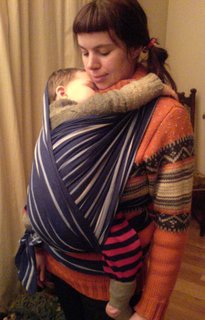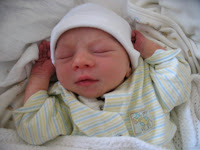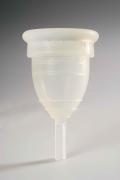
Carrying my son in a sling most of the time until around 6 months old made my life a lot easier and still does, I had two hands to carry on with whatever I was doing, he didn't cry as I was right next to him, I could walk round town and breastfeed him at the same time, we could go out anywhere until late at night, with him happily asleep against our bodies. As long as you have a good supportive wrap around type sling, and you wear it really tight it does not feel heavy, it just makes bending down harder and you have to do chores more slowly, but its worth it if your baby is happy and doesn't cry and need picking up constantly, and it feels so lovely having your baby next to you, imagine how heavenly it feels to them. My son has shown that he is very confident and independent since being able to move around so that proves to me that it does not make babies more clingy as some people speculate, quite the opposite.
I wish I had known the information below about slings below before I had given birth to Oscar, so thought I'd pass it on, I would not recommend the conventional carriers/slings from shops like Mothercare that just strap on as they are not very supportive at all, make your back hurt very quickly and worst of all put most people off carrying their baby which is such a shame.
WEBSITES
Great website with reviews and information about slings and the benefits, you need to register to get the good information:
http://www.thebabywearer.com/
A website with linked information on slings and there is a forum where you can chat with other baby wearing parents and meet up with local groups to try out/check out each others slings! You need to register on this one too:
http://www.slingmeet.co.uk
SLINGS
BABASLING: This is a side strap sling, so is very quick and easy to use which is advantageous with a wriggly crawling or toddling baby. My partner also uses this one a lot due to it being quicker and easier to use than a wrap. It is handy as the active baby can sit on your hip whilst supported by the sling and watch you cooking or going about your business, and for nipping round town etc. It can also be used for tiny babies in the hammock position and on your back too which is why I bought it in the first place. It is great for breast feeding even older/larger baby in public as they are hidden and snug lying in the sling and can fall asleep, and it takes the weight a bit for you. The disadvantage is that I find it hard to use this sling for more the 45 minutes at a time due to the weight being on one shoulder. It costs about £40.
http://www.babaslings.co.uk/home.htm
I consider the wrap style slings below to the most superior in terms of not giving you a bad back and versatility, they are a very long piece of fabric:
HUGABUB SLING: This is the wrap style sling I carried Oscar in for the first 6 months of his life, it was totally comfortable for my back [I had had back pain in pregnancy] and as long as I wore it correctly/tightly [your baby will be less heavy if tied closely to your body] I did not notice his weight at all, it does take a few minutes to put on each time, you need to re tie it now and again to keep it tight but would naturally take the baby out now and again anyway. Once you have wrapped the sling around you you need to flatten and spread out the cloth across your shoulders and hips to spread the weight. It does take a bit of practice and patience to get it right. This disadvantage of this sling is that is is made of stretchy cotton jersey material so is hard to use after your baby is 6 months old as stretches too much with their weight. It costs about £40.
http://www.hugabub.com/
DIDYMOS SLING: This is the wrap around sling and am now going to invest in, after trying many others, for Oscar and my future babies. The same advice applies as with the Hugabub above. This sling is very high quality, strong, non stretchy and worth the extra money, it has excellent reviews. You can use this to wear your baby/toddler on your back too which is a great advantage if you can get used to it, as easier to do things with your hands. It costs about £60 but worth the extra.
http://www.didymos.de/english/index_e.htm
There are lots of websites out there to find information about the above slings and others, and to find 2nd hand slings too, ebay.co.uk may be the easiest, although I know most parents like to hang onto their slings!
Some more great advice and slings on offer: http://www.littlepossums.co.uk/information/slings-faq.htm
The following is the best article I have ever read about the practical every day side of baby-wearing. There are some other interesting books more on the theory of carrying your baby, I think everyone should read this inspiring book who is having a baby even though it may appear quite extreme initially: The Continuum Concept by Jean Liedloff. You can find second hand slings on ebay and more reviews online.
Baby-wearing
Annalisa Barbieri
Saturday October 14, 2006
The Guardian
I'm expecting my second baby in December and really want to sling him/her. I did the pushchair thing the first time and from what I've heard and read, slinging a baby makes lots of things so much easier so am really keen to "baby-wear" this time!
Miranda Dunn, Derbyshire
I can't recommend baby-wearing enough. I only wish I had discovered it earlier than I did. We had a Wilkinet, £36.50, from birth, that was fab (www.wilkinet.co.uk, 0800 1383400) but it took me ages to work out I could also use it indoors and get on with things while carrying my baby, which is what they love, so they're more contented and cry less. My daughter was four months old before I discovered ring slings and even older before I discovered mei tais - traditional Asian carriers - and all the others out there.
Article continues
There are a few studies that show that babies who are slung (I use the word as a generic for all baby-wearing) cry far less. This is because babies are programmed to want to be close (no, it doesn't spoil them, quite the reverse) to a parent. But also we're all busy and have lives, so carrying a baby for any length of time is hard work. A good sling frees up your hands, distributes the weight over your back and shoulders and also holds the baby in a position that's good for their developing spines (avoid baby carriers that hold babies with their entire legs dangling and so put all the pressure on their lower back). A few things to remember: the closer your baby is slung to you, the lighter he will feel; you may get addicted and start a collection of slings; what works for one person may not work for another - I cannot stress this enough - so try a few out before you buy.
A great way to do this is through www.slingmeet.co.uk, which is a website dedicated to meeting other sling-wearers in your area to get information and try out their slings (as in the ones they own; it's not a shop). The other thing to remember is that slings take a bit of getting used to - there is a learning curve. Don't let this put you off, because like all good things, it's worth it.
Luckily, slings are mostly sold by parents who know their product and can advise in detail. It's not like going to a department store and being sold a pram by a 20-year-old who's never given birth, let alone been on a bus with a child and so will sell you a 15kg travel system.
In your shoes I would look at a wrap initially - these are literally great lengths of material that you wrap round you in a variety of ways and knot to fasten (yes they are safe if you follow the instructions). The beauty of them is that they are really comfortable, you can keep them on but pop baby in and out. Stretchy wraps such as the Moby, from £29.50 (from SaSa Slings, Little Possums or Baby-Bean) or Kari-Me, £41 (Little Possums) are easier as they have "give"; not-so-stretchy ones such as the Ellaroo Wrap, from £45 (Baby Bean, Little Possums, SaSa Slings) or Calin Bleu ones, from £27.50 (www.calinbleu.com, 0845 862 0073) are more supportive when baby gets heavier.
Ring slings are great because they're so easy - you literally shove baby in there and pull it to fit. The rings act as a tensioner, but not everyone gets on with them as they put all the weight on one shoulder and I found back carries difficult in them, but many mothers swear by their ring slings. Look at Zolowear (www.zolowear.com, 020-8810 6973), which makes great ring slings in cotton (around £55) or silk - the latter aren't cheap at around £100 but they are extremely beautiful and the UK rep is a mine of information.
One of the best-selling mei tais is the Kozy (www.kozycarriers.com), which you can only get from the makers in the US for about £40. It is supremely comfortable, and is suitable from birth (but takes confidence with a newborn).
A superb carrier for babies from six months (you can use from birth with the newborn insert, £12) is the Ergo, from £39.50 (www.freerangekids.co.uk, 01253 896290); this is very probably the carrier I hear most parents rave about more than any other. It's a soft-framed carrier, a bit like a rucksack, and I still carry my three-year-old daughter round in it for long stretches. I find it a godsend in the morning (at home) when she wants my attention but I have loads of things to do; she happily plays cars on the back of my head whilst I sort the day out. Two final things: baby's trousers can get pushed up in a sling, so invest in some fabulous baby-legs (like leg-warmers) to keep them warm, £6.50 from SaSa Slings. And www.thebabywearer.com is a superb site for all sling information including those studies I talked about.
www.baby-bean.co.uk, 01535 644800; www.littlepossums.co.uk, 01454 850446; www.sasaslings.co.uk, 01702 477234.
Contact Personal Shopper, The Guardian, 119 Farringdon Road, London EC1R 3ER or email: annalisa.barbieri@mac.com
Link to article >>








